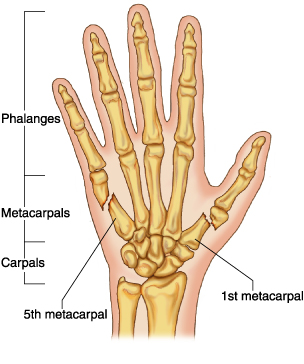10% of all fractures occur in the metacarpal bones, 40% of hand fractures involve the metacarpal bones and metacarpal fractures have an incidence of 2.5% during the lifetime of an individual. From the above statistics, it is quite evident that metacarpal fractures are a common occurrence. Within the sphere of metacarpal fractures, fractures involving the 5th metacarpal make up to 25% of all metacarpal fractures and 10% of all hand fractures.
What Is the 5th Metacarpal Bone?
The metacarpal bone of the 5th finger is placed between the phalanges of the little or pinky  finger and the carpals of the wrist. It is the second last scorer among the metacarpal bones in
finger and the carpals of the wrist. It is the second last scorer among the metacarpal bones in
terms of length and is the most laterally located metacarpal bone. Fractures in this bone are denoted as 5th metacarpal fractures.
There are 5 metacarpal bones and each metacarpal bone forms a connection between a finger and the wrist joint. The anatomy of all the metacarpal bones is the same. Each bone consists of four parts- the base, shaft, neck and head. The base is the segment of the metacarpal bone that is connected to the carpals of the wrist while the shaft lies in between the neck and base and is long and slender. The neck links the head with the shaft of the metacarpal and the head of the bone forms the connection between the phalanges and the neck. The knuckles of an enclosed fist are actually represented by the heads of metacarpal bones.
What Causes the 5th Metacarpal Fracture?
The 5th metacarpal suffers a fracture when a heavy blow is dealt on the hands by opposing force. For example, when boxers deal a punch with clenched fists, the heads of the metacarpals (knuckles) comes in direct contact with the opposing force and the entire blow is transmitted through the metacarpals. If the force is strong enough, it may break the metacarpal bones. This is why boxers suffer from metacarpal fractures and gloves are an absolute essential during such sport activities. Damage to the 5th metacarpal or other metacarpal bones can also be caused by a crushing blow by a heavy object falling a person's hand.
How Will You Know If You Have a 5th Metacarpal Fracture?
Several symptoms may together indicate the presence of a metacarpal fracture of the 5th digit:
- Pain, inflammation and swelling towards the ring finger end of the hand occur immediately after injury.
- Signs of bruising and tenderness may be present.
- Inability to use hands due to excruciating pain.
- The fractured region may feel cold and devoid of sensation and may also turn pale.
- A bump may develop in the injured area accompanied with the overall change in the shape of the hand.
Diagnosis
You must always seek the help of a doctor anytime you suspect the occurrence of a fracture or injury. Also, if your splinted or casted fractured area develops a tingling or numb sensation or the severity of pain in the area increases, you must immediately contact your doctor or visit the emergency room. Infections in the wounded region can be dangerous and if you happen to see any such signs, seek immediate medical aid.
The doctor will enquire about the history of your injury and ask you to describe the symptoms. Answer all questions carefully. You may also need to perform several tests such as:
- Hand X-rays
- A CT scan of the injured area which will provide a detailed image of your bones
- An MRI that uses radio waves and magnetic fields to produce a clear photograph of the affected bones
How Is It Treated?
5th metacarpal fractures can be treated in various ways depending on the nature of the fracture.
1. First-Aid for Fractures
In the first few hours after an injury, a few first-aid techniques will aid in reducing the painful symptoms. Application of ice gently to the spot of fracture, and keeping the fractured area elevated above the heart level, may help in decreasing some of the initial symptoms of this injury. Ice can be applied at intervals of 2 hours for a period of 20 minutes.
2. Rest
Any kind of activity may increase the complications of a 5th metacarpal fracture. Thus, it is advisable that the patient gets as much rest as possible during the healing period. Activities like weight lifting, pulling and pushing, gripping, knocking, etc. that subject the affected metacarpals to further damage, must be completely avoided. A full recovery is possible only after successful rehabilitation. The rehabilitation procedure must be conducted under the watchful eyes and advice of a well-trained physiotherapist.
3. Pain Relief Medications
Pain is one of the worst aspects of a fracture. Administration of anti-inflammatory medications and pain relievers like Ibuprofen (Advil) or Acetaminophen (Tylenol) are ideal for reducing the pain associated with a fractured area. The medications should only be taken on the advice of doctors to avoid harmful side effects.
4. Fracture Immobilization
Fractures which are not displaced can be healed with the help of casts or splints to immobilize the area. After removal of the casts or splints, a re-evaluation of the affected area needs to be performed using X-ray or other imaging techniques to ensure the area is completely healed. Only after sufficient healing, rehabilitation procedures can be adopted with the aid of a trained physiotherapist.
5. Anatomical Reduction
This method involves re-alignment of the distorted bone structure under the influence of anesthesia. This is usually applicable in cases of metacarpal fractures that include displaced bones, long, spiral fissures and fractures at bone joints. The anatomical reduction technique is followed by a cast or splint immobilization for a few weeks or surgical procedures. Surgery can involve invasive procedures or use external fixation methods where pins are inserted through the skin to stabilize the broken bones and allow time to heal the fracture.
